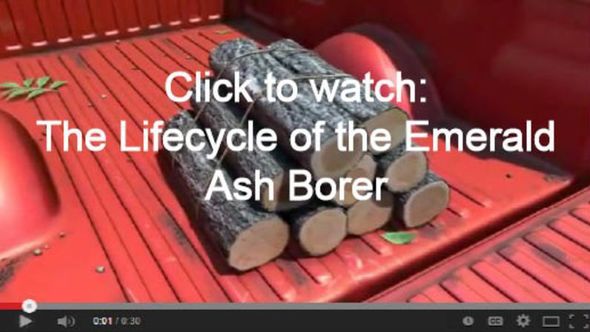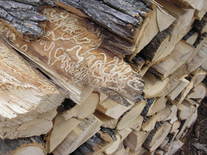|
Emerald ash borer (EAB) is a small, iridescent
green beetle that kills ash trees. The invasive insects lay their
eggs just inside the bark, and when the eggs hatch, the larvae eat the nutrient
layer of the tree, causing it to decline and eventually die.
EAB is a serious threat to all of Minnesota’s estimated 900 million ash trees. Signs of infestation include:
- Splitting bark
- Small (1/8”) “D” shaped exit holes where beetles emerge
- Serpentine “S-shaped” larval galleries underneath the bark
- Woodpecker activity
Below is the Minnesota Department of Agriculture’s (MDA) video on the lifecycle of the EAB.

EAB in Minnesota
All ash trees are susceptible to
EAB and millions of ash trees have been killed already in other states. Minnesota
is especially vulnerable because we have more ash trees than any
other state. Ash trees make up 15.1
percent of the trees in Minnesota communities, but in some cities account
for as much as 25 to 30 percent of the tree canopy. Thus, EAB poses a
devastating economic and environmental threat to our state.
The current EAB infestation in Minnesota
affects the Twin Cities area as well as Winona, but the insect spreads quickly
and there are no known native predators to stop
EAB in North America.
 Human activity is the major culprit behind the spread of EAB through transported firewood. To prevent further movement, affected counties are under state and federal quarantines which make it illegal to move any ash wood or products. EAB quarantines are now in effect for the counties of Hennepin, Houston, Ramsey and Winona.
It is common for people to unknowingly carry EAB with them by bringing infested firewood on a picnic or camping trip. The most important thing you can do to protect Minnesota from EAB is to avoid moving infested ash wood. Here’s how:
- Buy firewood wherever you are camping instead of bringing it with you.
-
Dispose of ash wood properly by observing the county quarantines.
|
What do you do if you have an ash tree?
If you live outside of Hennepin, Houston, Ramsey or
Winona counties, EAB has not yet been detected near your home. If you have an
ash tree, learn
to identify ash trees and EAB.
-
Contact
MDA’s program, "Arrest the Pest" if you
see signs of EAB.
- Do not treat your ash trees with insecticides,
as EAB is not yet present in your county. Avoid unnecessary use of
insecticides, which should only be used when pests pose an immediate threat.
- Enjoy your ash tree and watch the news for
updates on EAB presence in your community.
If you live in Hennepin, Houston, Ramsey or Winona
counties, EAB is known to live near your home. If you have an ash tree,
-
Determine whether your tree is infested with
EAB. Because larvae are inside the bark, it is often difficult to detect EAB.
Visit MDA’s webpage “Does
My Tree Have Emerald Ash Borer (EAB)?” to learn more.
-
If your tree does not have EAB, healthy trees in
these counties have the option of being treated to avoid infestation. Learn
about insecticide options in
this handout (pdf). To reduce chemical use, we recommend careful
consideration before you treat your tree.
- If your tree already has EAB, or it is healthy
but you choose not to treat it, it will eventually get EAB and die. Monitor
your tree and safely remove it before it becomes a hazard.
-
If you cut the tree yourself, be sure to bring
all the wood waste to a disposal site within your county. You must not move any
part of this tree (or other wood) outside of your county. Look at MDA’s website for drop
off locations for your downed tree. Don’t
leave stumps or branches in your yard for decoration or play; quick disposal
will destroy any emerging adults from infested wood and top them from flying to
nearby trees.
-
When you cut your ash tree down, replant
with a new tree!
Forest Pest First Detector
Sign up and become a Minnesota
Forest Pest First Detector to become active in scouting for EAB and other
invasive pests in your community. First Detectors are the front line of defense
against infestations and your help detecting these pests early helps to
minimize the impact they can cause.
 Kristin Taggart, Minnesota
GreenCorps Urban Forestry member serving in the city of Hutchinson, works
on the city’s EAB preparedness program.
She works to increase community awareness of EAB and other invasive
species by developing diversification projects, planting trees, connecting with
homeowners and helping create Arbor Day programs with local schools.
“With the threat of EAB fast
approaching, ash trees are the primary target for removal and replacement over
the next 10-15 years. Further public outreach and education on the importance
and benefits of a sustainable urban forest are essential to my GreenCorps
project,” said Kristin. If you think your community would benefit from an EAB
preparedness program as well, encourage community leaders to apply to be a
GreenCorps host site.
Minnesota
GreenCorps, an environmentally focused AmeriCorps program, is now accepting
member and host site applications in preparation for another year of preserving
and protecting Minnesota’s environment. Urban forestry is just one of their
programs. They also serve projects in the areas of energy conservation, green transportation, waste
prevention, local foods, stormwater, and living green.
|
Interested in educating others on how
to live a healthier, more sustainable lifestyle? If so, consider presenting at
the 2014 Sustainability Stage in the Eco
Experience building at the 2014 Minnesota State Fair. Demonstrations and performances on a variety
of topics including yard and garden, energy, water, food and creative ventures.
To apply, read the detailed instructions on the online application form then
fill out the application and submit it electronically. Applications due April 11, 2014.
Join Do It Green! for their inaugural fundraiser in support of their 14th year of sustainability
education in Minnesota communities! April
17, 6:30 p.m., Summit Brewery, (St Paul).
Join Metro
Clean Energy Resource Team (CERT) Spring Resource & Networking event. Hear about clean energy projects, work that is
happening in communities all over the 11 county metro area and find
out how to start a project in your community. April 17, 4:00 p.m.-8:00 p.m., Bullard
Rainforest Auditorium at Como Park Zoo Visitor Center, (St Paul).
The Iron Range
Partnership for Sustainability will host an Earth Fest celebration of local traditions and practical resources for sustainable
living on the Iron Range of Northeastern Minnesota. April 26, 9:00
a.m.-4:00 p.m., Mt Iron Community Center, Messiah Lutheran Church and Merritt
Elementary, (Mt. Iron, MN).
Celebrate Arbor Day this year! April 25
kicks off an entire month of celebrations and incentives for replacing trees
lost during the past years' tornadoes, floods, blowdowns, and snowstorms. Visit
the DNR’s 2014
Arbor Month page to locate a
celebration near you. Check out the Minnesota’s Arbor Month Celebration, which
includes the state’s tree climbing championship, nature play opportunites,
education and musical performances. May
17, 9:00 a.m.-12:00 p.m., Oak Hill Park, (St. Louis Park).
Send questions or comments about living green to the address
below.
Sincerely,
Taylor Holland and the Living Green Team
livinggreen365.pca@state.mn.us
|